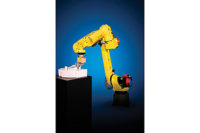There are many ways to linearly move an object from point A to point B on an assembly line. But, not all of them are designed to optimize speed, accuracy and repeatability while performing the task.
Linear indexing systems are definitely designed with this goal in mind. And fortunately for manufacturers, many types of these systems are available and have a proven track record of success over the past several decades.
One type is the pallet-transfer conveyor, which has become all the rage in recent years. Equally effective, however, are precision-link conveyors (PLCs) and walking beams.
“A pallet-transfer-conveyor offers constant speed but lacks dynamic motion control. Therefore, it is only efficient up to about 15 cycles per minute,” says Bill Beezer, engineering manager at Stelron Components Inc. “In contrast, a precision-link conveyor is much more rugged and able to accurately index up to 100 cycles per minute.”
Last year, a medical-device manufacturer installed four custom Stelron PLCs. Three of the conveyors feature a carousel-style chassis and work together to assemble blood-centrifuge cylinders. At the customer’s request, Stelron manufactured, assembled and mounted custom fixtures to these conveyors, according to Beezer.
On the other conveyor, which has an over-under chassis, Stelron mounted four MD-2 through-hole indexers to efficiently feed blood-platelet-separator parts to the chassis links. Beezer says the indexers’ large through-hole also makes it easy to run air tubes and cables to pneumatic grippers, ancillary cam-driven components and robotic devices.
Success stories like this one are quite commonplace for PLCs, as well as walking beams. Both are “old reliable” technologies that perform successfully year after year with little fanfare—which is just fine for manufacturers in industries as diverse as automotive, medical devices, white goods, packaging, consumer goods and electrical components.
A Different PLC
Developed in the 1950s, the PLC is great for the automated assembly of products with 10 or more parts. The conveyor indexes a precise stroke, at which point equipment mounted at the side performs an assembly function. This event is then repeated many times along the entire length of the conveyor until the product is complete.
PLCs are only used in applications where assembly accuracy is critical; never to simply feed parts to a line. The conveyors are powered by a cam- or servo-driven rotary indexer, and they consist of machined plates, or pallets that are linked together in a chain like tank treads. This chain rides in tracks between two large sprockets.
Roller bearings enable the plates to move smoothly along the tracks and to pivot as they move around the sprockets. Part fixtures are mounted directly to the plates, which are made of aluminum, steel or cast iron. Aluminum plates are lighter and less expensive, but can stretch over time in high-speed applications.
The conveyor comes in over-under and carousel configurations. In the former, the plates are parallel with the floor; in the latter, they’re perpendicular. With an over-under conveyor, work can only be performed on the top pallets. This makes the over-under configuration more suited to processes, like pressing or screwdriving, that may put a little more force onto the conveyor.
In contrast, a carousel conveyor enables manufacturers to have assembly stations along both sides of the machine. Some carousel conveyors even enable the use of the conveyor’s radiused ends for assembly stations, thereby further optimizing its cost-effectiveness.
The conveyors come in many sizes and have a link pitch of 3 to 9 inches. Modular tabletop systems range in length from 2 to 30 feet, with custom lengths also available. Heavy-duty conveyors feature a solid base and heavily ribbed legs to support large loads.
Modular systems have a wide, open frame so pick-and-place units, timing chains and power lines can be located in the center of the machines. Larger conveyors can be built with an open configuration, or with a closed configuration for increased rigidity.
During operation, the PLC has a move-dwell-move motion, which comes from a globoidal (sphere) or barrel cam driven by a DC motor. The conveyor can index continuously, or it can index on a signal from a programmable logic controller or a switch activated by an operator.
For added flexibility, the conveyor can be programmed to index half a pallet length, a full pallet length or double the pallet length. Locking mechanisms, such as shot pins, may be used to increase pallet positioning accuracy.
Several factors need to be considered when selecting a PLC. Engineers need to know the total weight of the parts and fixtures; the number of stations; the cycle rate; pallet length; index distance; dwell time; operating environment; and accuracy requirements.
Each conveyor is built to the customer’s specific requirements. Non-standard requests may include tapped holes, mounting plates, through holes in the chassis, special drive units, special-shaped conveyors, custom pitches or strokes, and custom coatings on the components. Custom link cover plates can be ordered to prevent particulate intrusion to the track and increase safety by eliminating pinch points around the radius.
“What manufacturers love most about the PLC is not only that it allows for many workstations in a small space, but for many different types of workstations,” notes Ray Tynczuk, applications engineer at Destaco, a Dover Co. “These stations can feature equipment as diverse as mechanical actuators, robots, presses, ultrasonic welders and vision inspection systems.”
Ravi Shivanna, product development engineer manager at Destaco, points out that where each type of equipment is located often depends on the required accuracy of that particular assembly process. According to Shivanna, the CAMCO engineered take-up cam profile design achieves constant tension and a high degree of accuracy and repeatability.
Destaco introduced its heavy-duty series of PLCs in the 1970s. Some 20 years later, the company developed a CAMCO modular series. These conveyors come in carousel and over-under style, tabletop or base-mounted, and have a link pitch of 3, 4.5 or 6 inches, with special-size pitches available.
Tynczuk says the conveyors are popular among manufacturers because the modular frame offers fixed-increment length changes, which allow for standard configurable center-distances. All conveyor links feature roller-bearing cam followers for smooth transfer and long life. The conveyors are driven by either a standard index drive or a gearhead/servo motor. Overload protection is standard in the motorized index drive system.
“When we entered the precision-link conveyor market in 1995, there were several companies making this type of equipment,” says Beezer. “Many machine builders were also making these conveyors for their own use in-house.”
Stelron bases each custom PLC it builds on the company’s standard P-Link chassis. Beezer says the chassis is capable of ±0.003 inch accuracy when built with a shot-pin locking beam that is synchronized to the main indexing system. Links measure either 3 by 3, 4.5 by 3, 6 by 6 or 6 by 9 inches in the pitch direction. The largest link has a capacity of 60 pounds, and can transfer a total payload in excess of 1,000 pounds.
“As the number of assembly processes and stations increase, a PLC is better than a dial-indexer-type assembly machine in terms of floor space efficiency and parts-fixtures accessibility,” claims Barry Eilert, sales manager of automation products at Sankyo Automation. “Its design also makes machine integration and maintenance easier to perform. The PLC’s only limitation is that it’s unable to do asynchronous motion patterns, as its lone drive simultaneously moves all links and part fixtures.”
Automotive part and consumer goods manufacturers are regular users of Sankyo PLCs. According to Eilert, these applications frequently require indexing more than one link at a time, with a positioning time under 0.5 second.
Sankyo offers conveyor straight sections in 480-millimeter-long increments, up to about 10 meters. Link size is 80, 120, 160, or 240 millimeters, and feed pitch accuracy is ±0.1 millimeter. Each link is preloaded in all directions to eliminate backlash, increase machine accuracy and improve dynamic performance.
To ensure that the full chain remains in proper tension during motion, Sankyo uses a chordal compensating cam on the idler side of the conveyor. This cam also allows for faster indexing speeds with reduced machine vibrations and quick settling times.
Walking to Work
Walking beams have also been around for a long time and involve a relatively simple mechanical concept: A lift and carry motion transfers a part or parts along a linear path, from one process step to the next, through the use of an indexing system.
Initial walking beam systems were used to slowly move automotive and other large parts down an assembly line. The beam was located above or set off to the side of the process path and featured hooks that would simultaneously lift several part-loaded baskets or racks and index them to the next position. After moving the items, the beam was disengaged and returned in preparation for the next indexing event.
Modern walking beams are cam-actuated systems that index rail-based pallets with parts on them to one or more workstations. Lifting and walking beams work in sync to ‘lift and shift’ the pallet, as it were, and are powered by the same cam.
After the lifting beam engages the pallet from below and places it onto a track, the walking beam moves the pallet forward and back in controlled, accurate increments to each indexed station. There, assembly process equipment can access the pallet from all sides.
“A walking beam is inherently designed for continuous indexing motion, whereas a PLC is frequently set up to only cycle on demand,” says Beezer. “As a result of the continuous motion, the walking beam has better dynamics and inherently higher accuracy, but can be more costly.”
Stelron’s Recirculating Walking Beam assembly chassis is a synchronous, palletized system that provides 15 to 150 indexes per minute. The pallets are moved in a rectangular pattern around the tabletop by synchronized, cam-actuated walking beams.
The process begins with the walking beam engaging a pallet (4 to 8 inches square) with dowel pins, and indexing it horizontally one pallet pitch. Before the walking beam’s dowel pins disengage, a mechanically synchronized locking beam engages each pallet with two low-clearance shot pins. This design separates the moving and locking functions of the chassis and results in long-term accuracy in the X, Y and Z axes.
Fabricated from resilient, self-lubricating Delrin, the pallets can serve as nests, or fixtures can be mounted to them. Positional accuracy is ±0.001 inch at all stations, including the ends.
A wide range of table lengths (up to 30 feet or longer) and widths are available, since modules can be combined. Ample space between pallet tracks allows pick-and-place units, tooling and other mechanisms to be mounted inside the tracks.
In 2019, a pump spray manufacturer installed a complex assembly system that consists of a PLC, a walking beam and a multistation rotary indexing dial. All three components are made by Stelron.
“This system assembles 20 or so parts to build the heads that are used in spray cans,” says Beezer. “Parts start on the PLC and then get moved onto a dial indexer for some assembly work. These subassemblies get transferred to the walking beam for yet more processes, then back onto another dial and back again to the PLC to complete the assembly.”
Because the walking beam is a fixed system, its stroke length is completely determined by the designed cam profile, according to Tom Mikrut, sales director at Destaco. He adds, though, that a walking beam requires no maintenance and is great for lower-speed, high-repeatability applications.
“Walking beams are capable of handling high process forces as long as the locating devices and fixturing are designed properly,” concludes Eilert. “The cycle time is typically slower than a PLC because of the extra lifting motions required, but is still better than conventional asynchronous pallet transfer machines.”









